lock CADILLAC CATERA 1997 1.G Owners Manual
[x] Cancel search | Manufacturer: CADILLAC, Model Year: 1997, Model line: CATERA, Model: CADILLAC CATERA 1997 1.GPages: 338, PDF Size: 18.02 MB
Page 8 of 338

Downloaded from www.Manualslib.com manuals search engine Vehicle Symbols
These are some of the symbols you may find on your vehicle.
For example,
these symbols
are used on an
original battery:
POSSIBLE A
CAUTION
INJURY
PROTECT EYES
BY
SHIELDING Q
CAUSTIC
BURNS AVOID
SPARKS
OR
FLAMES
SPARK
OR ,\I/,
COULD FLAME
EXPLODE BATTERY
These symbols are important
for you and
your passengers
whenever your
vehicle
is
driven:
DOOR LOCK
UNLOCK
FASTEN SEAT
BELTS
POWER
WINDOW
These symbols have
to do with
your lamps:
SIGNALS e 9
TURN
WARNING
A
HAZARD
FLASHER
RUNNING * 0
DAYTIME - 0
LAMPS '**
FOG LAMPS $0
These symbols
are on some
of
your controls:
WINDSHIELD
WIPER
WINDSHIELD DEFROSTER
WINDOW
DEFOGGER
VENTILATING FAN
These symbols are used on
warning and
indicator lights:
COOLANT -
TEMP -
CHARGING 1-1
BATTERY
SYSTEM
BRAKE
(a)
R
ENGINE OIL
PRESSURE
Wb
ANTI-LOCK (@)
BRAKES
Here are some other symbols
you may see:
FUSE
LIGHTER
m
HORN )tr
SPEAKER
b
FUEL B
vii
Page 11 of 338

Downloaded from www.Manualslib.com manuals search engine Seats and Seat Controls
This section tells you about the seats -- how to adjust
them, and also about reclining front seatbacks, lumbar
adjustments, heated seats and head restraints.
Manual Front Passenger’s Seat
Lift the lever to tilt the front portion of the seat cushion
up or down. Release the lever to lock the seat into place.
This feature is available on the passenger’s seat only.
Lift the bar under
the front passenger’s seat to unlock it.
Slide the seat to where you want it and release the
bar.
Try to move the seat with your body to be sure the seat
is locked into place,
1-2
Page 14 of 338
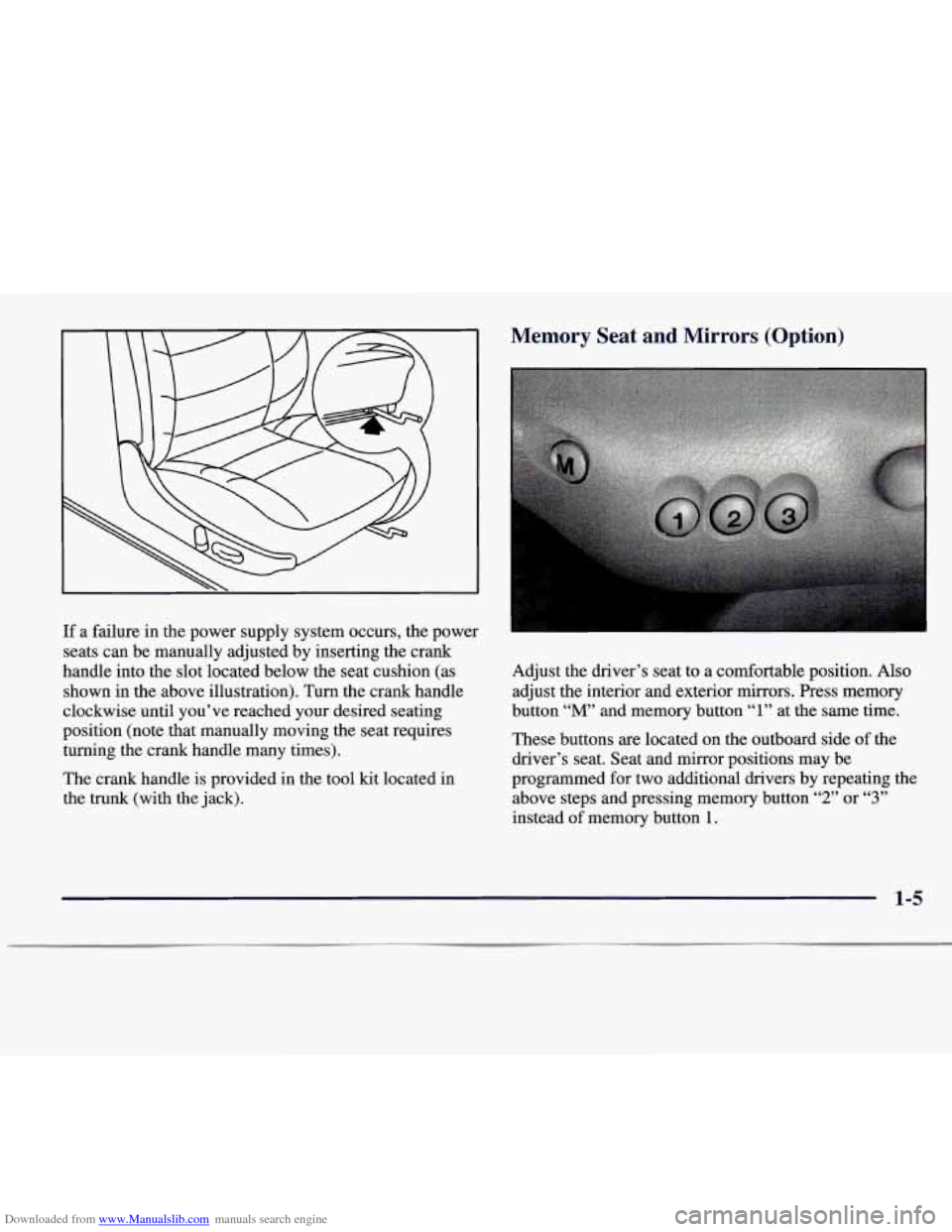
Downloaded from www.Manualslib.com manuals search engine If a failure in the power supply system occurs, the power
seats can be manually adjusted by inserting the crank
handle into the slot located below the seat cushion (as
shown in the above illustration). Turn the crank handle
clockwise until you’ve reached your desired seating
position (note that manually moving the seat requires
turning the crank handle many times).
The crank handle is provided in the tool kit located in
the trunk (with the jack).
Memory Seat and Mirrors (Option)
Adjust the driver’s seat to a comfortable position. Also
adjust the interior and exterior mirrors. Press memory
button
“M’ and memory button “1” at the same time.
These buttons are located on the outboard side
of the
driver’s seat. Seat and mirror positions may be
programmed for two additional drivers by repeating the
above steps and pressing memory button
“2” or “3”
instead of memory button 1.
1-5
Page 19 of 338

Downloaded from www.Manualslib.com manuals search engine Rear Seats
Folding the Rear Seat
With the rear folding seatbacks, you can carry long
cargo by folding down part or all of the rear seat. To
unlock the rear seatback, press the pushbutton at the top
of the seat and fold the seatback forward.
To return the seat to the passenger position, lift up on the
seatback and push it rearward
until it latches. After returning the seat
to the passenger position, pull
forward on the seatback to make sure it is locked into
place. Also, return the safety belts to their original
positions,
so they will be available for rear seat
~ passengers to use.
The panel behind the rear seat armrest also folds. Turn
the knob counterclockwise and pull the panel forward to
gain access to the trunk.
1-10
Page 26 of 338

Downloaded from www.Manualslib.com manuals search engine Driver Position
This part describes the driver’s restraint system.
Lap-Shoulder Belt
The driver has a lap-shoulder belt. Here’s how to wear
it properly.
1. Close and lock the door.
2. Adjust the seat (to see how, see “Seats” in the Index)
so you can sit up straight.
3. Pick up the latch plate and pull the belt across you.
Don’t let it get twisted.
The shoulder belt may lock if you pull the belt across
you very quickly. If this happens, let the belt
go back
slightly to unlock it. Then pull the belt across you
more slowly.
4. Push the latch plate into the buckle until it clicks.
Pull up on the latch plate to make sure it is secure.
If the belt isn’t long enough, see “Safety Belt
Extender’’ at the end
of this section.
Make sure the release button on the buckle is
positioned
so you would be able to unbuckle the
safety belt quickly if you ever had to.
1-17
Page 27 of 338

Downloaded from www.Manualslib.com manuals search engine 5. To make the lap part tight, pull down on the buckle
end of the belt as you pull up on the shoulder belt. The lap part of the belt should
be worn low and snug on
the hips, just touching the thighs. In a crash, this applies
force to the strong pelvic bones. And you’d be less likely \
to slide under the lap belt.
If you slid under it, the belt
would apply force at your abdomen.
This could cause
serious or even fatal injuries. The shoulder belt should go
over the shoulder and across the chest. These parts of the
body are best able to take belt restraining forces.
The safety belt locks
if there’s a sudden stop or crash, or
if you pull the belt very quickly out of the retractor.
Page 28 of 338
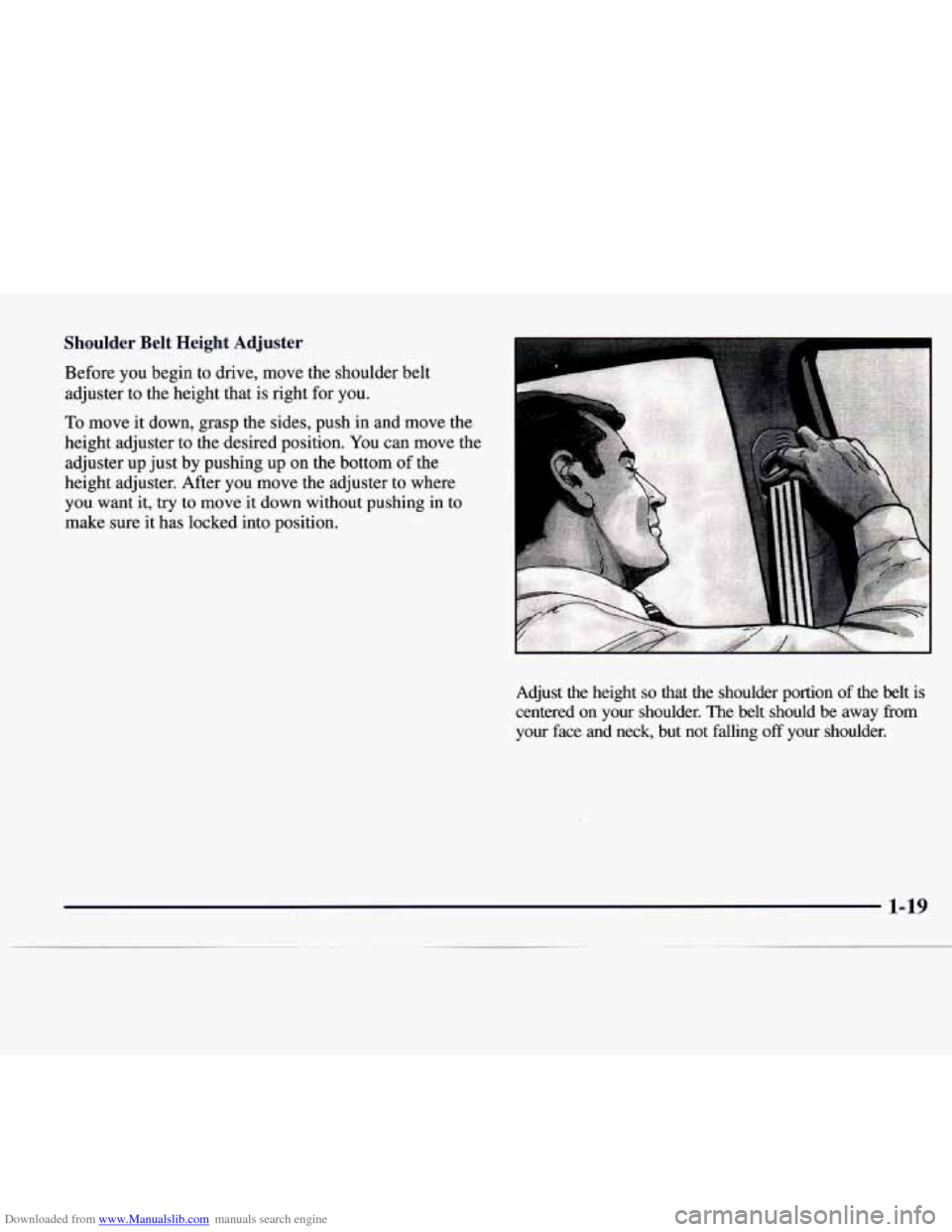
Downloaded from www.Manualslib.com manuals search engine Shoulder Belt Height Adjuster
Before you begin to drive, move the shoulder belt
adjuster to the height that is right for you.
To move it down, grasp the sides, push in and move the
height adjuster to the desired position. You can move the
adjuster up just by pushing
up on the bottom of the
height adjuster. After you move the adjuster to where
you want it,
try to move it down without pushing in to
make sure it has locked into position.
Adjust the height
so that the shoulder portion of the belt is
centered
on your shoulder. The belt should be away fkom
your face and neck, but not falling off your shoulder.
1-19
Page 34 of 338
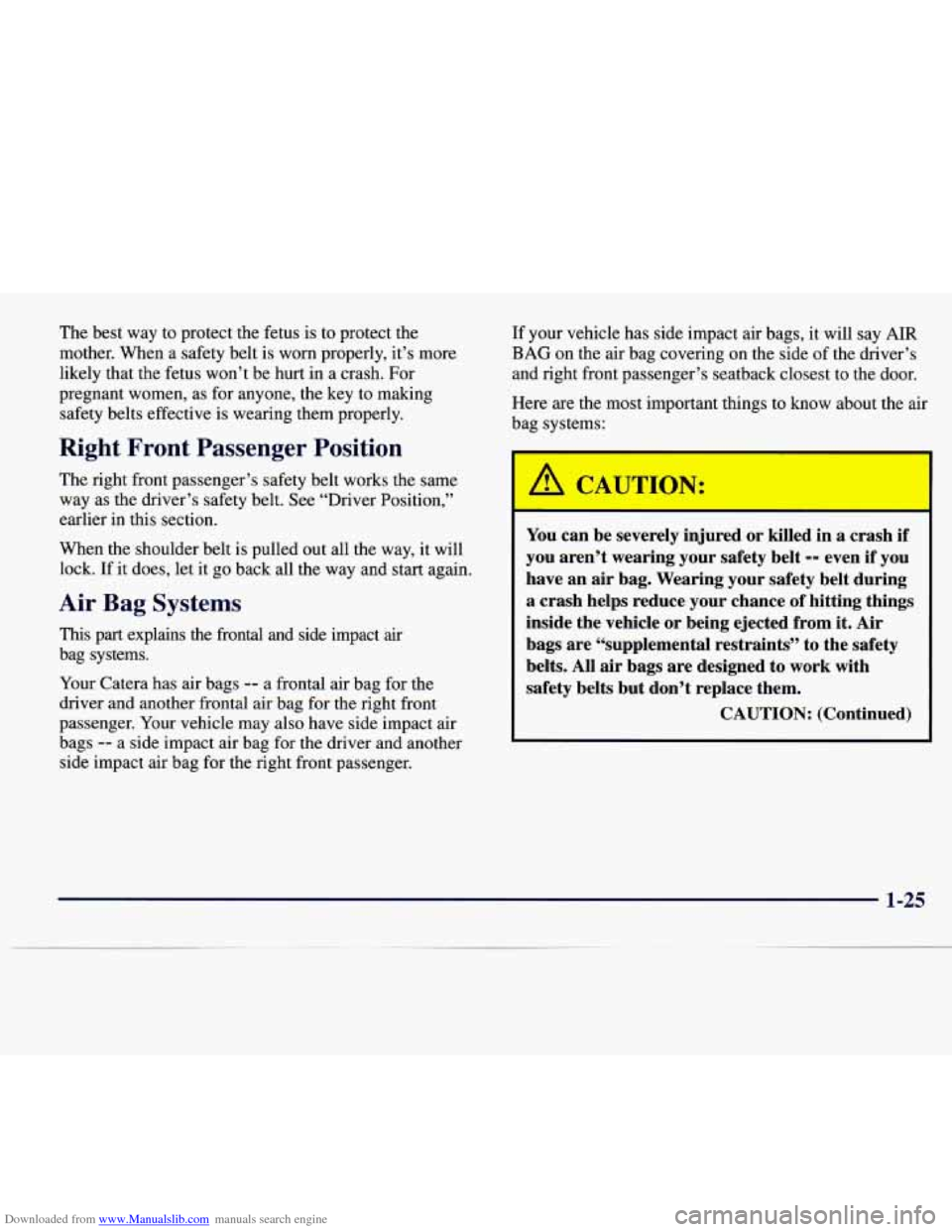
Downloaded from www.Manualslib.com manuals search engine The best way to protect the fetus is to protect the
mother. When a safety belt is worn properly, it’s more
likely that the fetus won’t be hurt in a crash. For
pregnant women, as for anyone, the key to making
safety belts effective is wearing them properly.
Right Front Passenger Position
The right front passenger’s safety belt works the same
way as the driver’s safety belt. See “Driver Position,”
earlier in this section.
When the shoulder belt is pulled out all the way, it will
lock. If it does, let it go back all the way and start again.
Air Bag Systems
This part explains the frontal and side impact air
bag systems.
Your Catera has air bags
-- a frontal air bag for the
driver and another frontal air bag for the right front
passenger. Your vehicle may also have side impact air
bags
-- a side impact air bag for the driver and another
side impact air bag for the right front passenger. If
your vehicle has side impact air bags, it will say
AIR
BAG on the air bag covering on the side of the driver’s
and right front passenger’s seatback closest to the door.
Here are the most important things to know about the air
bag systems:
You can be severely injured or killed in a crash if
you aren’t wearing your safety belt
-- even if you
have an air bag. Wearing your safety belt during
a crash helps reduce your chance of hitting things
inside the vehicle or being ejected from
it. Air
bags are “supplemental restraints’’ to the safety
belts. All air bags are designed to work with
safety belts but don’t replace them.
CAUTION: (Continued)
1-25
Page 38 of 338
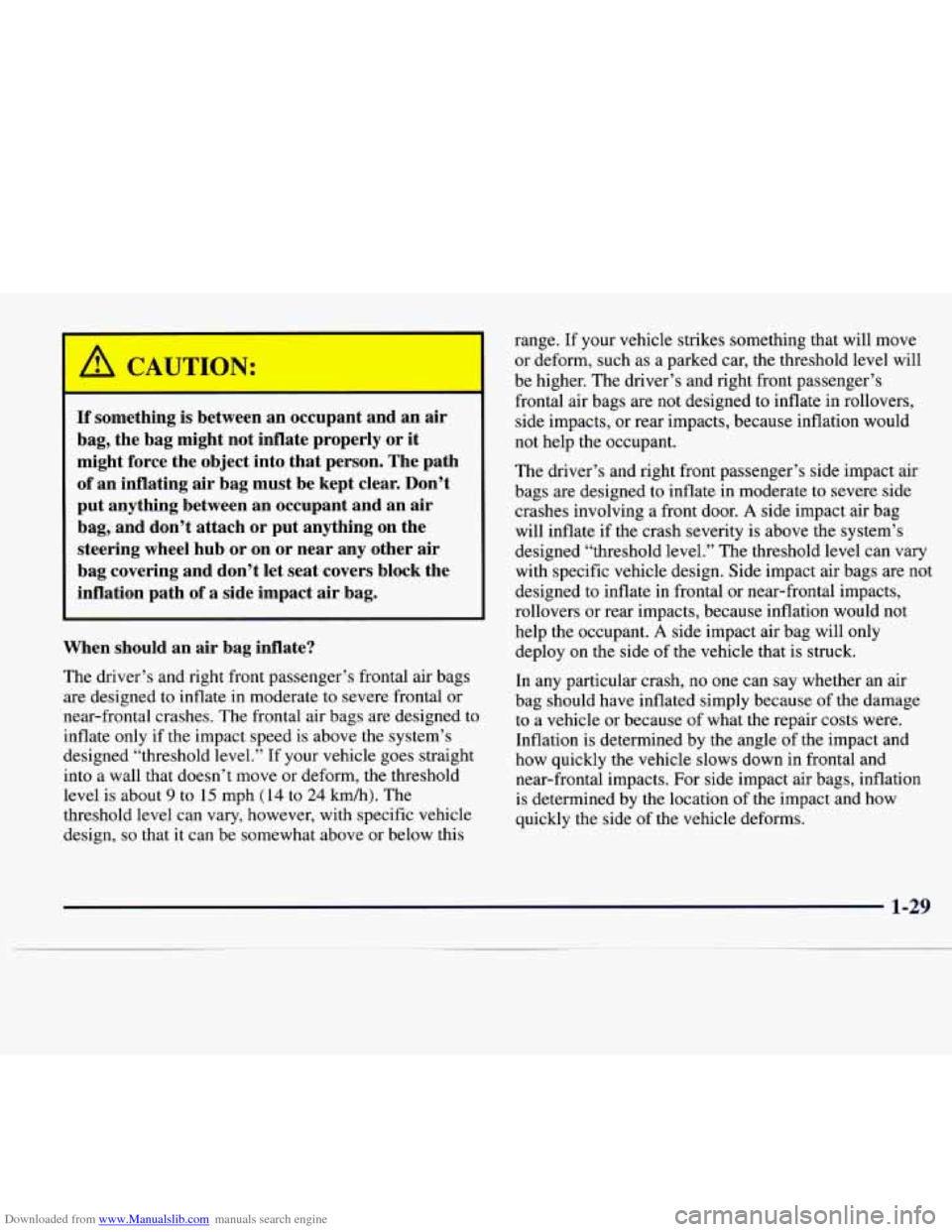
Downloaded from www.Manualslib.com manuals search engine I a CAUTION:
If something is between an occupant and an air bag, the bag might not inflate properly or it
might force the object into that person. The path of an inflating air bag must be kept clear. Don’t
put anything between an occupant and an air
bag, and don’t attach or put anything on the
steering wheel hub or on or near any other air
bag covering and don’t let seat covers block the
inflation path of a side impact air bag.
When should an air bag inflate?
The driver’s and right front passenger’s frontal air bags
are designed to inflate in moderate to severe frontal or
near-frontal crashes. The frontal air bags are designed to
inflate only if the impact speed is above the system’s
designed “threshold
level.” If your vehicle goes straight
into a wall that doesn’t move or deform, the threshold
level is about
9 to 15 mph (14 to 24 km/h). The
threshold level can vary, however, with specific vehicle
design,
so that it can be somewhat above or below this range.
If your vehicle strikes something that will move
or deform, such as a parked car, the threshold level will
be higher.
The driver’s and right front passenger’s
frontal air bags are not designed to inflate
in rollovers,
side impacts,
or rear impacts, because inflation would
not help the occupant.
The driver’s and right front passenger’s side impact air
bags
are designed to inflate in moderate to severe side
crashes involving
a front door. A side impact air bag
will inflate if the crash severity
is above the system’s
designed “threshold level.’’ The threshold level can vary
with specific vehicle design. Side impact air bags are not
designed to inflate in frontal or near-frontal impacts,
rollovers
or rear impacts, because inflation would not
help the occupant.
A side impact air bag will only
deploy on the side of the vehicle that is struck.
In any particular crash, no one can say whether an air
bag should have inflated simply because
of the damage
to a vehicle or because of what the repair costs were.
Inflation is determined by the angle
of the impact and
how quickly the vehicle slows down in frontal and
near-frontal impacts. For side impact air bags, inflation
is determined by the location of the impact and how
quickly the side of the vehicle deforms.
Page 42 of 338
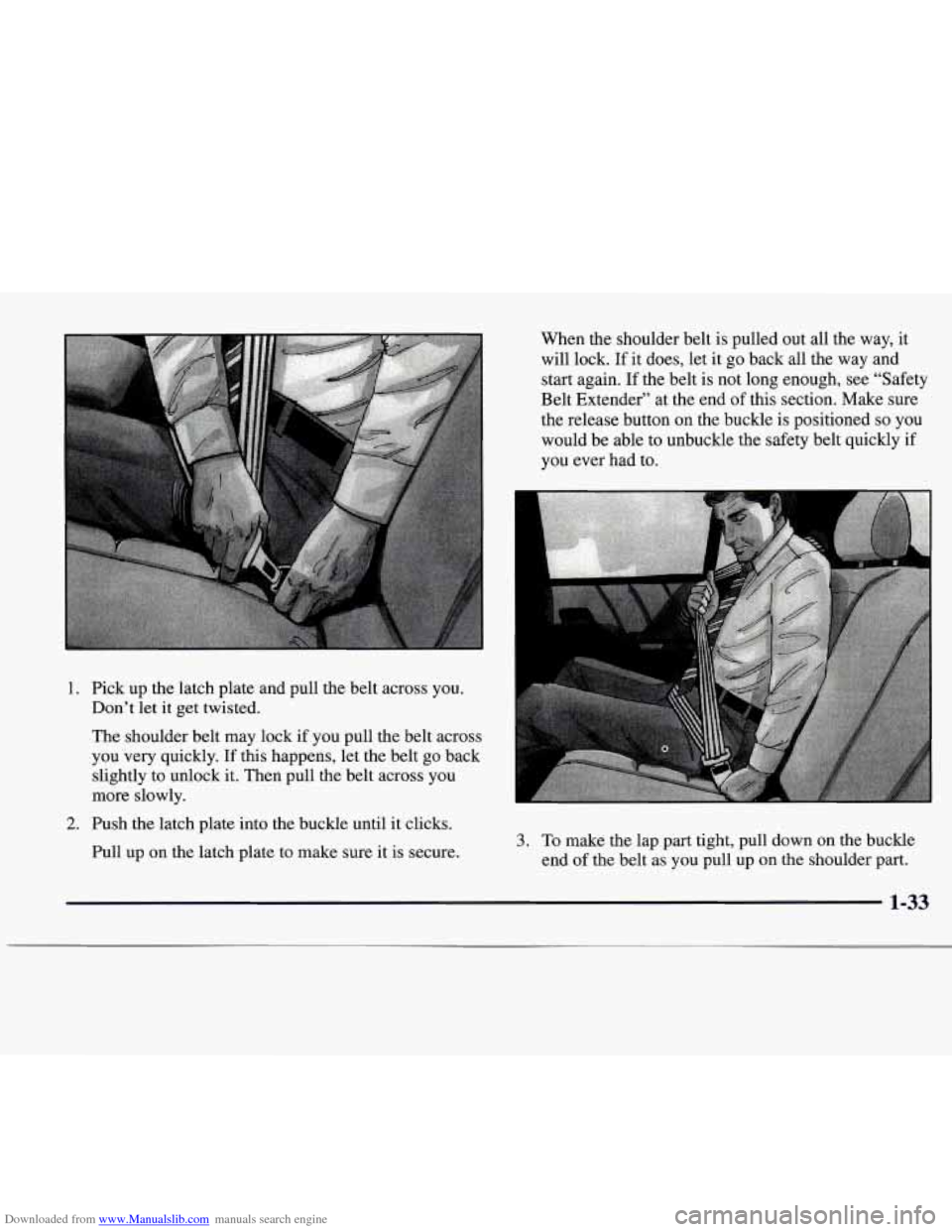
Downloaded from www.Manualslib.com manuals search engine 1. Pick up the latch plate and pull the belt across you.
Don’t let
it get twisted.
The shoulder belt may lock if you pull the belt across
you very quickly.
If this happens, let the belt go back
slightly to unlock it. Then pull the belt across you
more slowly.
2. Push the latch plate into the buckle until it clicks.
Pull up on the latch plate to make sure it is secure. When
the shoulder belt is pulled out all the way,
it
will lock. If it does, let it go back all the way and
start again. If the belt is not long enough, see “Safety
Belt Extender” at the end of this section. Make sure
the release button
on the buckle is positioned so you
would be able to unbuckle the safety belt quickly
if
you ever had to.
3. To make the lap part tight, pull down on the buckle
end of the belt as you pull up on the shoulder part.
1-33